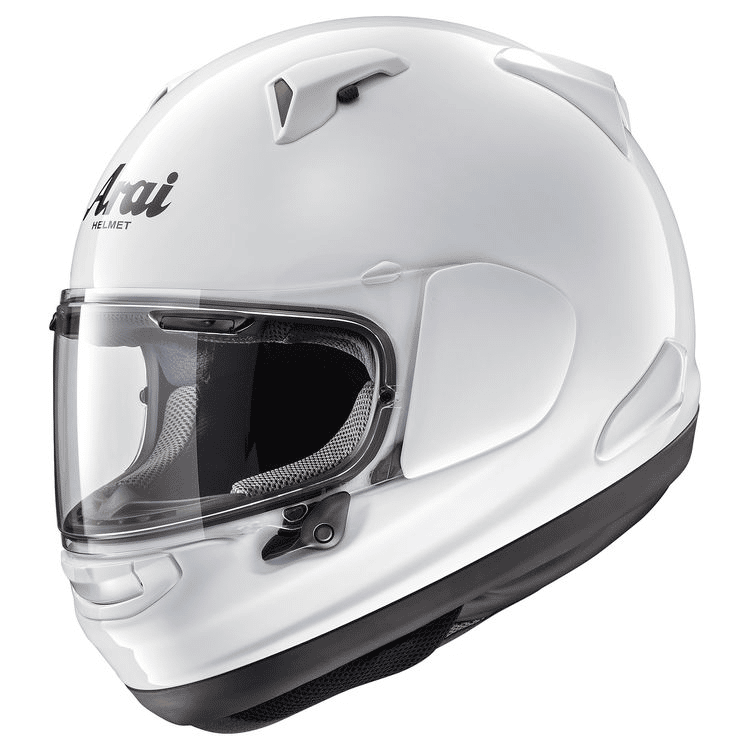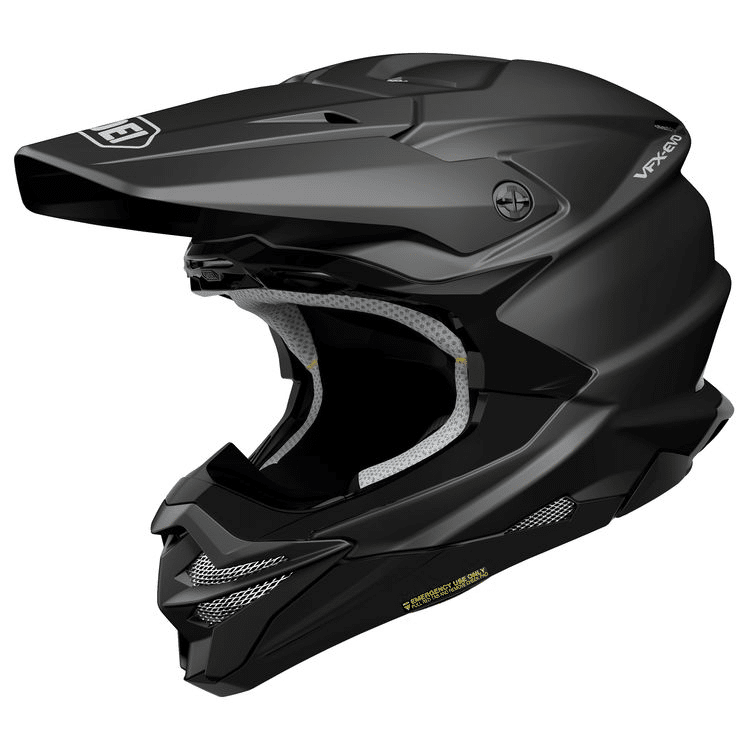The freedom of the open road and the wind running across you as you ride is a feeling hard to describe. But, with the excess freedom you get from motorcycling comes the responsibility to ride with a suitable, safe motorcycle and safety gear. In this article, we’ll break down everything you need to know when choosing the safest motorcycle helmet. Whether your state requires wearing a motorcycle helmet by law, you should ALWAYS ride with a helmet. Use of DOT-compliant motorcycle helmets was 64.9% in 2021, not statistically different at the 0.05 level from 69.0 percent in 2020 (read our Motorcycle Accident Statistics article).
We’ve assembled a guide on the top 10 safest motorcycle helmets you can buy in 2023 based on the helmet safety ratings from experts.
What are the Safest Motorcycle Helmets in 2023?
AGV K6 Helmet
($336.46 – $349.97)
The AGV K6 boasts a lightweight carbon-aramidic fiber shell. Its aerodynamic design and ventilation system are well-thought-out, promoting stability at high speeds. When it comes to safety, it meets ECE 22.05 and DOT standards, ensuring comprehensive protection for the rider. Given its price point, this helmet offers good value for riders prioritizing safety.

Scorpion EXO-R420 Helmet
($159.95 – $164.95)
The Scorpion EXO-R420 is a testament that safety doesn’t always come with a hefty price tag. Meeting both Snell M2015 and DOT standards, it provides commendable safety features. The polycarbonate shell is sturdy, and the EverClear no-fog face shield adds convenience. While not as premium as some of its counterparts, it provides solid protection at a budget-friendly price.

Shoei RF-1400 Helmet
($579.99 – $659.99)
Renowned for its quality, the Shoei RF-1400 Helmet stands out for its Advanced Integrated Matrix Plus (AIM+) shell which maximizes high-speed impact safety. Boasting both DOT and Snell certification, it’s clear that safety is paramount in its design. The dual-layer multi-density EPS liner offers enhanced impact absorption, making it a top contender for those prioritizing safety, albeit at a higher price.

Schuberth C5 Helmet
($769.00 – $785.00)
The Schuberth C5 Helmet, known for its modular design, brings both convenience and safety. Built with Direct Fiber Processing (DFP) shell construction, it ensures maximum strength and protection. With integrated antennas for enhanced communication, noise reduction, and DOT/ECE certification, the C5 places itself as a high-end option for riders desiring both safety and integrated features.

Shoei X-15 Helmet
($899.99 – $919.99)
A race-ready helmet, the Shoei X-15 is designed for high-speed performance without compromising safety. Its multi-layered and multi-dense EPS liner provides optimum protection against impacts. Meeting both DOT and Snell standards, it integrates superior aerodynamics and ventilation, justifying its premium price tag. For racers and those who don’t mind splurging, it stands out as a top-tier option.


Shoei Neotec 2 Helmet
($799.99 – $819.99)
The Shoei Neotec 2 Helmet blends convenience with safety, offering a modular design without compromising protection. With its AIM shell and dual-layer EPS liner, it ensures robust impact protection. It holds DOT certification and integrates features like an integrated sun shield and optimized aerodynamics. For those seeking versatility with safety, it is an excellent high-end option.

Motorcycle Helmet Safety Scheme and Ratings
Motorcycle helmets serve the fundamental purpose of protecting a rider’s head during an impact. However, not all helmets are created equal. The presence of specific stickers on the back of a helmet signifies the safety standards it adheres to. These stickers aren’t just decorative badges; they are a testament to the rigorous testing that the helmet has undergone.
DOT (Department of Transportation)
This is the standard determined by the U.S. Department of Transportation. Helmets that carry the DOT sticker are compliant with the federal standard FMVSS 218. If you’re riding in the U.S., DOT certification is the bare minimum you should look for.
ECE (Economic Commission for Europe)
Recognized by over 50 countries, this standard signifies that the helmet meets the ECE 22.05 requirements. It’s similar in nature to the DOT standards, but with variations in testing parameters and details.
SNELL (Snell Memorial Foundation)
Unlike DOT and ECE, which are mandatory for helmets sold in their respective regions, SNELL is a voluntary standard. Helmets undergo additional and sometimes more rigorous testing to obtain this certification. The current SNELL standard for street use is SNELL M2020.
FIM (Fédération Internationale de Motocyclisme)
As the governing body for motorcycle racing globally, FIM has set its standards primarily for track use helmets. It’s a testament to a helmet’s suitability for high-speed impacts and race conditions.
While it is essential for your helmet to have at least one of these stickers, helmets that boast multiple certifications offer assurance that they meet several stringent safety criteria. For instance, a helmet that is both DOT and SNELL certified has met the safety requirements set by both organizations.
However, be wary of helmets without any of these stickers. Often referred to as “novelty” helmets, they might look like the real deal but offer no protection. These are not only unsafe but also illegal in places where wearing a certified helmet is mandatory.
THE 3 MAIN FEATURES OF THE SAFEST MOTORCYCLE HELMETS

Current helmet technology involves an inner liner to absorb shock, made of EPS (expanded polystyrene) foam. In addition, there is a comfort liner that riders often mistake for a protective component, which also does provide some padding. A helmet should also have EPS foam in the lower area to properly protect the face and jaw.
- When considering a helmet, always look for a shell-built design. The first line of defense protects your head to avoid direct contact with the road. Choose another helmet if the helmet you picked doesn’t have thermoplastic or reinforced composite shell-like polycarbonate.
- The second feature to look for is the impact-absorbing liner. As the name suggests, it is the helmet’s inner liner, which not only gives comfort to your top head but also absorbs impact in crashes. The second line of defense protects you from severe head injuries.
- The third feature is the chin strap, a helmet can only do its job if it’s adequately strapped.
MOTORCYCLE HELMET SAFETY STANDARDS
There are several safety standards for motorcycle helmets, and knowing what they cover can be confusing. The most important criterion of a helmet is its safety rating. Here are the primary safety standards and what you need to know about each:
SNELL MEMORIAL FOUNDATION (M-95 / M2000)
The Snell Foundation certification is not a requirement by law anywhere. However, they go above and beyond the minimum criteria to thoroughly test helmets in many respects. They also test for bicycling, karting, and professional motorsports. Below are the safety features they test for:
- Impact Testing: The impact test uses controlled impacts to simulate different impact surfaces. The object is to measure gravitational (G) force or acceleration. If the peak acceleration in any test exceeds a value, the helmet is rejected.
- Positional Stability (Roll-Off) Test: A head form is mounted to point the face downward at an angle of 135 degrees. The helmet is placed on the head form, and the straps and buckles are adjusted to obtain the best-fit condition. Weight is connected via wire rope and dropped from a determined height. The helmet is turned 180 degrees, and the test is conducted again. The helmet may shift but must not roll off the head form to pass the test.
- Dynamic Retention Test: The helmet is placed on a head form with the chin strap fastened under a device representing the jaw. The jaw piece has a 23 kg weight applied for around one minute. The retention system is tested by removing the 23 kg weight and applying a 38 kg mass in an abrupt guided fall. The retention system fails if it cannot support the mechanical loads or if the maximum instantaneous deflection (stretch) exceeds 30 mm (1.18 inches).
- Chin Bar Test: The test helmet is attached to a base with the chin bar facing upward. A 5 kg weight is dropped to hit the central portion of the chin bar. The maximum downward deflection of the chin bar must not exceed the stated distance.
- Shell Penetration Test: The test helmet is attached to a base. A sharp-pointed 3-kg object is dropped from a prescribed height. The test striker must not penetrate the helmet or even achieve momentary contact with the head from inside the helmet.
- Face Shield Penetration Test: The face shield (also called a visor) is attached to a test helmet and shot along the centerline in three places with an air rifle. The rifle shoots sharp, soft lead pellets at approximately 500 kph (310 mph). The pellets must not penetrate the visor for it to pass the test.
D.O.T. (DEPARTMENT OF TRANSPORTATION FMVSS218)
FMVSS218 is the technical standard that defines the minimum criteria a helmet manufacturer must certify against in the United States. It’s known as the DOT helmet standard certification generally. The tests are very similar to the Snell Memorial tests. Still, the judged values are slightly different on criteria for impact, severity, and test equipment used. As a result, the Snell certification is more difficult to pass than the DOT testing. One additional note is that the manufacturer certifies their helmets in their labs. In contrast, Snell tests and certifies any helmet submitted to them from any manufacturer.
EUROPEAN STANDARD 22/05
The European standard is similar to the DOT and Snell testing. The values and tests vary slightly on most criteria, and it also adds a retention standard testing for slipping, abrasion, retention, and durability. One additional test for helmet shell rigidity is done under the ECE 22/05 standard, not done under Snell or DOT.
EUROPEAN BSI 6658-85 TYPE A
Europe also has a second standard that helmets are measured by, which is very close to the Snell testing scheme. Passing values on specific tests vary slightly from the Snell standard. Still, many of the categories list the benefits as the “same as the Snell M2005 test” as a reference. The BSI tests also incorporate the chin strap slippage, retention, and abrasion testing seen on the ECE 22/05.
SHARP
SHARP is a testing and rating system only available for helmets sold in the UK (United Kingdom / England). It measures the impact protection of the helmet based on similar testing to the other standards and rates helmets with a star rating system instead of a pass/fails result. The ratings are shown from 1 to 5 stars.
When To Replace Your Motorcycle Helmet
A common consensus insists helmets should be replaced every five years, even assuming you have not had any direct impacts that would jeopardize the impact protection of the helmet. This recommendation is mainly from helmet manufacturers and the Snell Memorial Foundation after studying the effects on a helmet from regular use. There is no evidence we’re aware of that suggests a well-maintained, undamaged helmet will suddenly lose its ability after five years. Deterioration is gradual, and many variables can slow down or speed up that process.
Motorcycle Helmet Degradation
Helmet degradation happens from normal wear and tear, hair oils, body fluids, and cosmetics. Cleaners, paints, fuels, and other materials affect the liner materials and overall helmet performance. Here are some tips to help prolong helmet degradation:
- Follow the manufacturer’s care instructions for your helmet
- Use the mildest soap recommended
- Exposure to potent cleaning agents can cause the helmet to decompose and lose protective value. Avoid any petroleum-based cleaning fluids, especially with polycarbonate helmets.
- Keep your helmet’s face shield clean. Typically, mild soap and warm water with a cloth will work. If it gets scratched and vision is impaired, replace it.





















